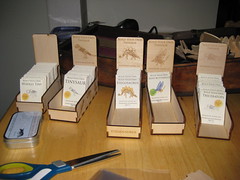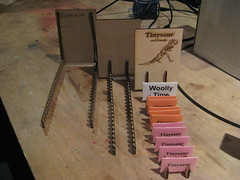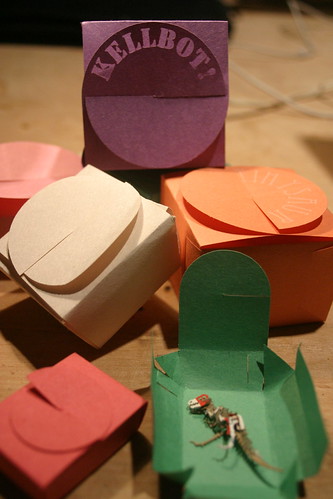Most of the last week has been spent prepping for a craft show, my first one in about two years. In order to get ready for the craft show, and also to attract some more wholesale clients, I’ve been working on some nice wooden display stands for Tinysaur.
 These are the displays I’m using for the upcoming show. They’re laser cut/etched wood. Each stand holds a different model Tinysaur. The stand on the far left is a prototype, hence its lack of a dinosaur etching.
These are the displays I’m using for the upcoming show. They’re laser cut/etched wood. Each stand holds a different model Tinysaur. The stand on the far left is a prototype, hence its lack of a dinosaur etching.
Each display holds about 30 Tinysaurs. Each Tinysaur is contained in its own matchbook-style packaging. I plan on using these displays to transport the Tinysaurs, but more on that later.
Designing a display takes a while, and is an iterative process. The first time I cut one, I realized the front piece was too short, and had to make a new one. I also decided the runners on the sides were too short, it looked a little stumpy. So I added two more inches to it. Which turned out to look a little ridiculously long.

When I took the first raster-etched stand out of the laser, I realized I’d made another mistake. I forgot to mirror the right-hand runner, so the dinosaur silhouettes ended up on the wrong side. Oops.
I also had to do some experimenting with the raster image of the dino that appears on the “flag.” The line drawings have a lot of thin lines, which tends to look sort of anemic when etched. I went into Photoshop and used a combination of filters to beef up the lines. You can see the difference in this picture.
Lastly there was the issue of transport. The flags that stick out of the top make it sort of unweildy to pack, and they’re also sort of fragile. Rather than risk them breaking off in transit, I made a second set of backs which are only as tall as the sides.

Then I drilled a few holes in each side of the stand. Since I want the backs to be removable, I don’t want to glue them on. Instead I’m going to run some elastic through the holes and around the back. That way I can switch the backs out easily, and they’re held in place by elastic.
I think the elastic will work OK, but it’s sort of fiddly. I think a beter option would be to use some small bolts to keep things in place. Something to think about for the next version.


